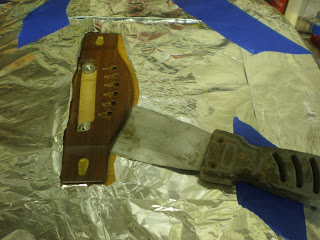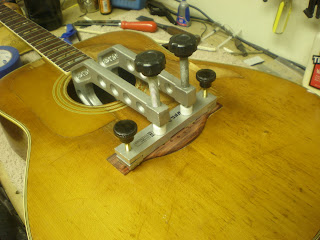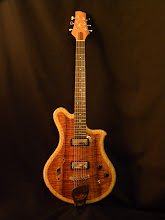Today started much like yesterday...with some clean up!

Hide glue fingerprints are everywhere!

After a little bit of sanding everything is cleaned up! The next step is to add the vertical reinforcement strips which help to strengthen the sides.

One more.

Here's one with the clamps taken off.

With the vertical strips installed I add a bit of kerfed lining over the top. When the glue dries, the ring is ready for the top and back

11:00am
As the glue drys, I head over to Guru. During this week My brothers in arms, Gene and Horward had their own projects to tackle...
A customer brought in his 60's Vox Starstream. He asked Gene to reverse engineer the onboard effects and build them into a stompbox!

It's a huge project. Here's Gene in middle of the prototyping process.

A few of the parts in the original are not available any more, so Gene had to figure out some modern alternatives. Wires everywhere!

So far, it looks, and sounds cool though!

Meanwhile, Howard, is in the home stretch of refinishing a mid 60's Fender bass 5. I had no idea that 5 string basses were made that early!. When the customer brought this bass in, it was in bad shape. Someone tried a DIY refinish job and the body was pretty awful! After much rebuilding, he's getting close now! It's ready to assemble with a fresh finish and a custom machined re-production bridge(the old original was missing).

I was interested to see how the Yamaha was doing!

The bridge glued on great! so it was time to make the saddle.

And then a new nut.

I drill the bridge pin holes a bit small so I can ream them out for a nice fit.

With the strings on everything is looking good!

The finished nut.

Action is looking a lot better!

This guitar really turned out great! All of the hard work paid off!

It plays great! Another one brought back from the edge! I'm sure the customer will be really happy!

On to the next one...and oh what a tough one it is! Just kidding. Only a bad output jack! It takes a couple of minutes to solder in a new one.

Up next? a funky...

Conquerer Bruno!

...and by funky...I mean funky!

It's nice of somebody to mark the bridge location! Ha!

The electronics were not working. I thought there was a big problem, but they just turned out to be really dirty! So, A good cleaning was in order.


Before I knew it, 5:30pm rolled around, and I had to get going...We're off to be reasonable and non-confrontational at Jon Stewart's Rally to Restore Sanity! Have a great weekend everybody! Thanks for checking out the blog! I plan to keep posting pictures of the archtop build. Stay tuned for that!





































